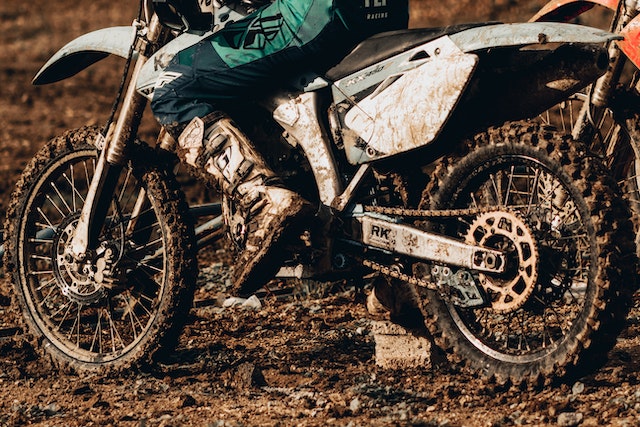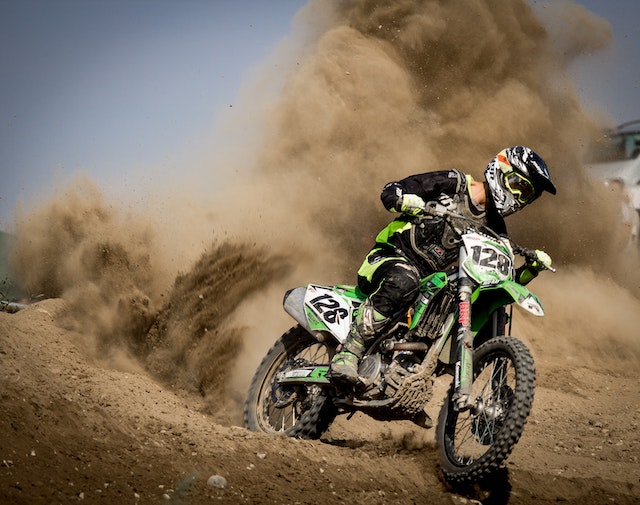Dirt biking, the thrilling sport of riding specially-designed motorcycles off-road, is an adrenaline-pumping adventure that offers countless challenges and rewards. But what is a dirt bike? Allow me to dig deep into the core components, designs, and capabilities of dirt bikes.
Anatomy of a Dirt Bike
A dirt bike is uniquely designed to tackle rough terrain. Here are the key parts that define it:
- Suspension: Provides the ability to absorb large shocks on bumpy trails.
- Engine: Typically two-stroke or four-stroke engines, designed to offer a balance of power and weight.
- Tires: Equipped with deep, aggressive treads for better grip on loose or muddy surfaces.
- Frame: Light and agile to make the bike easy to maneuver.
Dirt Bike vs Motorcycles: The Key Differences
| Feature | Dirt Bikes | Motorcycles (Street Bikes) |
|---|---|---|
| Purpose and Terrain | Off-road riding on trails and rough terrains | On-road usage on paved roads |
| Design and Construction | Lightweight, rugged, long suspension, high clearance | Heavier, stable, aerodynamic, low clearance |
| Tires and Wheels | Knobby, deep-treaded, smaller wheel diameter | Smoother, less aggressive, larger wheel diameter |
| Engine and Performance | Smaller engines, agile, good power-to-weight ratio | Larger engines, sustained speed and power |
| Seating and Ergonomics | Upright seating, narrow seat, taller handlebars | Relaxed seating, handlebars for long-ride comfort |
| Accessories and Features | Minimalistic, fewer accessories | Wind protection, storage, electronic aids |
| Legality and Registration | Often not street-legal | Designed to be street-legal |
Certainly! Though dirt bikes are a specific category of motorcycles, they have distinct characteristics that differentiate them from standard motorcycles (often referred to as street bikes). Here’s a detailed comparison between the two:
1. Purpose and Terrain
- Dirt Bikes: Specifically designed for off-road riding, including trails, dirt paths, and rough terrains. Suitable for jumps, stunts, and outdoor adventures.
- Motorcycles: Primarily built for on-road usage, including commuting, touring, and cruising on paved roads.
2. Design and Construction
- Dirt Bikes: Lightweight, rugged construction with longer suspension travel to handle bumps and jumps. Generally higher ground clearance to navigate obstacles.
- Motorcycles: Heavier and built for stability and comfort on smooth surfaces. Lower ground clearance and a more aerodynamic design for highway speeds.
3. Tires and Wheels
- Dirt Bikes: Knobby, deep-treaded tires for maximum grip on loose surfaces. Smaller wheel diameters for better maneuverability off-road.
- Motorcycles: Smoother tires with less aggressive treads, designed for grip on paved surfaces. Larger wheel diameters for stability at high speeds.
4. Engine and Performance
- Dirt Bikes: Often have smaller, more agile engines, either two-stroke or four-stroke, providing a good power-to-weight ratio for quick acceleration and control off-road.
- Motorcycles: Typically have larger, four-stroke engines designed for sustained speed and power on the road, with a broader range of performance options.
5. Seating and Ergonomics
- Dirt Bikes: Upright seating position, narrower seat, and taller handlebars for active riding and standing up when necessary. Encourages an engaged riding stance.
- Motorcycles: More relaxed and cushioned seating, handlebar positioning for comfort during long rides. Variations include sport, cruiser, or touring ergonomics.
6. Accessories and Features
- Dirt Bikes: Minimalistic, with fewer accessories to reduce weight. Often lacks features like windshields, large fuel tanks, or saddlebags.
- Motorcycles: May include wind protection, storage compartments, advanced electronic aids, and other comfort features for prolonged road use.
7. Legality and Registration
- Dirt Bikes: Many dirt bikes are not street-legal and are restricted to off-road use. Some dual-sport models are exceptions.
- Motorcycles: Designed to be street-legal, meeting all necessary regulations and standards for road use.
Different Types of Dirt Bikes
Dirt bikes are designed to cater to a variety of riding styles and terrains, and they can be classified into several distinct types.

Motocross Bikes (MX)
- Purpose: Designed for competitive racing on specially crafted tracks.
- Features: Lightweight, high ground clearance, aggressive suspension, and powerful two-stroke or four-stroke engines.
- Example Brands: Honda, Kawasaki, Yamaha.
Trail Bikes
- Purpose: Ideal for casual off-road riding on trails, including wooded or rocky paths.
- Features: Slightly softer suspension, more user-friendly, built for comfort and control rather than speed.
- Example Brands: Suzuki, KTM.
Enduro Bikes
- Purpose: Built for long-distance off-road and on-road journeys, including competitions like the famed Dakar Rally.
- Features: Strong frame, more substantial fuel tank, road-legal with mirrors and lights, balanced suspension for various terrains.
- Example Brands: BMW, Husqvarna.
Dual-Sport Bikes
- Purpose: Versatile bikes that can tackle both off-road trails and paved roads.
- Features: Street-legal, comfortable seating, balanced performance for on-road and off-road use.
- Example Brands: Kawasaki, Yamaha.
Trials Bikes
- Purpose: Specific for trials riding, a discipline that requires precise control and balance to navigate obstacles without putting a foot down.
- Features: Extremely lightweight, minimalistic design, low seat height, less powerful engine.
- Example Brands: GasGas, Beta.
Adventure Bikes (ADV)
- Purpose: These are larger bikes intended for long-distance travel, capable of tackling various terrains, including off-road.
- Features: Comfortable seating, large fuel tank, luggage options, more substantial build.
- Example Brands: BMW, Ducati.
Freestyle Motocross Bikes (FMX)
- Purpose: Specifically built for performing aerial stunts and tricks.
- Features: Highly customized based on rider preferences, lightweight, modified suspension for jumping.
- Example Brands: Customized versions of major brands like Honda, Yamaha.
Electric Dirt Bikes
- Purpose: Eco-friendly off-road riding.
- Features: Battery-powered, quieter, various power and range options.
- Example Brands: Zero Motorcycles, Alta Motors.
Each type of dirt bike is crafted with particular riding conditions and experiences in mind. Whether you’re an extreme sports enthusiast looking to perform breathtaking jumps or a long-distance traveler aiming to explore the backcountry, there’s a dirt bike tailored to your needs and desires.
Bottom Line
In the captivating world of two-wheelers, the choice between a dirt bike and a standard motorcycle isn’t merely a decision between two types of vehicles; it’s a choice between two distinct lifestyles, adventures, and experiences.
A dirt bike beckons the thrill-seeker, eager to conquer the untamed trails, navigate challenging terrains, and perhaps even defy gravity with leaps and bounds. It’s a symbol of agility, freedom, and the wild spirit of off-road exploration.
In contrast, a standard motorcycle offers the allure of the open road, the comfort of smooth rides, and the pleasure of long-distance journeys. Whether it’s a scenic coastal highway or the bustling city streets, the road motorcycle embodies grace, power, and style.
The considerations between these two marvelous machines go beyond mere specifications. It’s about aligning with your riding passions, understanding your needs, and selecting the bike that resonates with your heart.
Whether you hear the call of the wild trails or the melody of the open road, there’s a bike waiting for you, ready to embark on a memorable adventure. So gear up, choose your path, and let the journey begin.
Happy riding!

